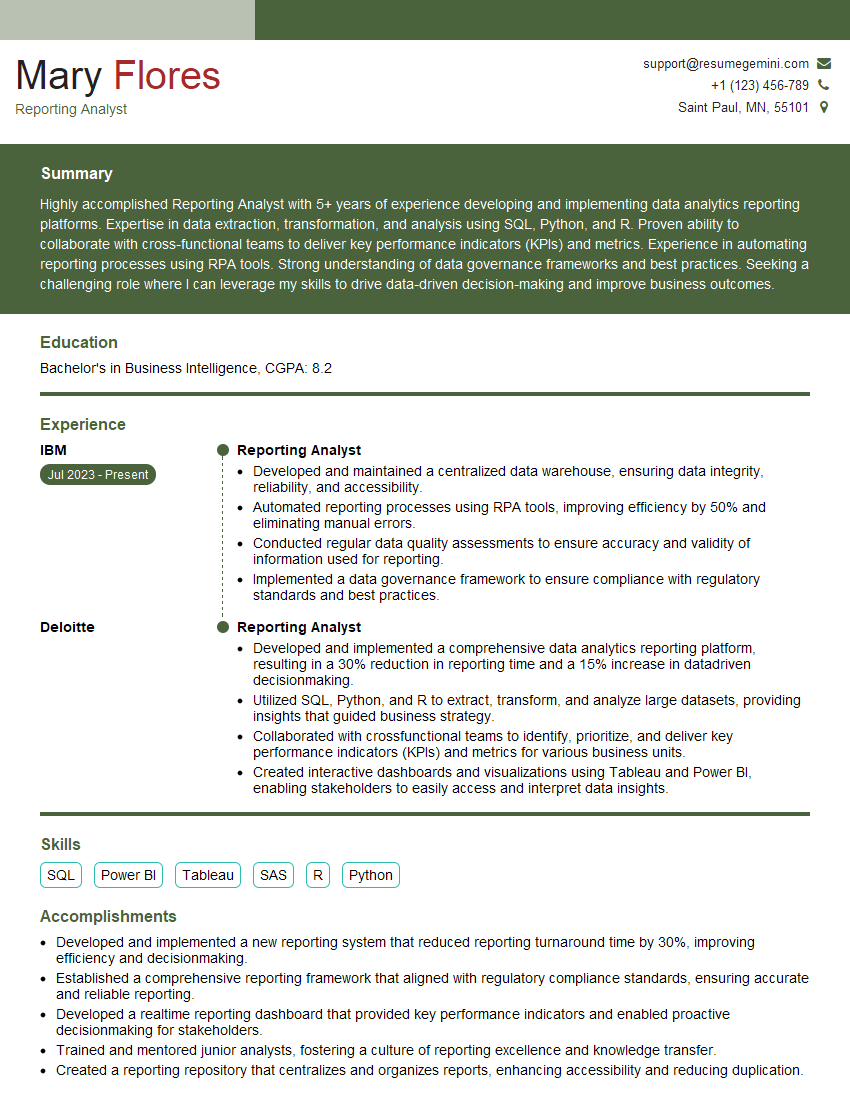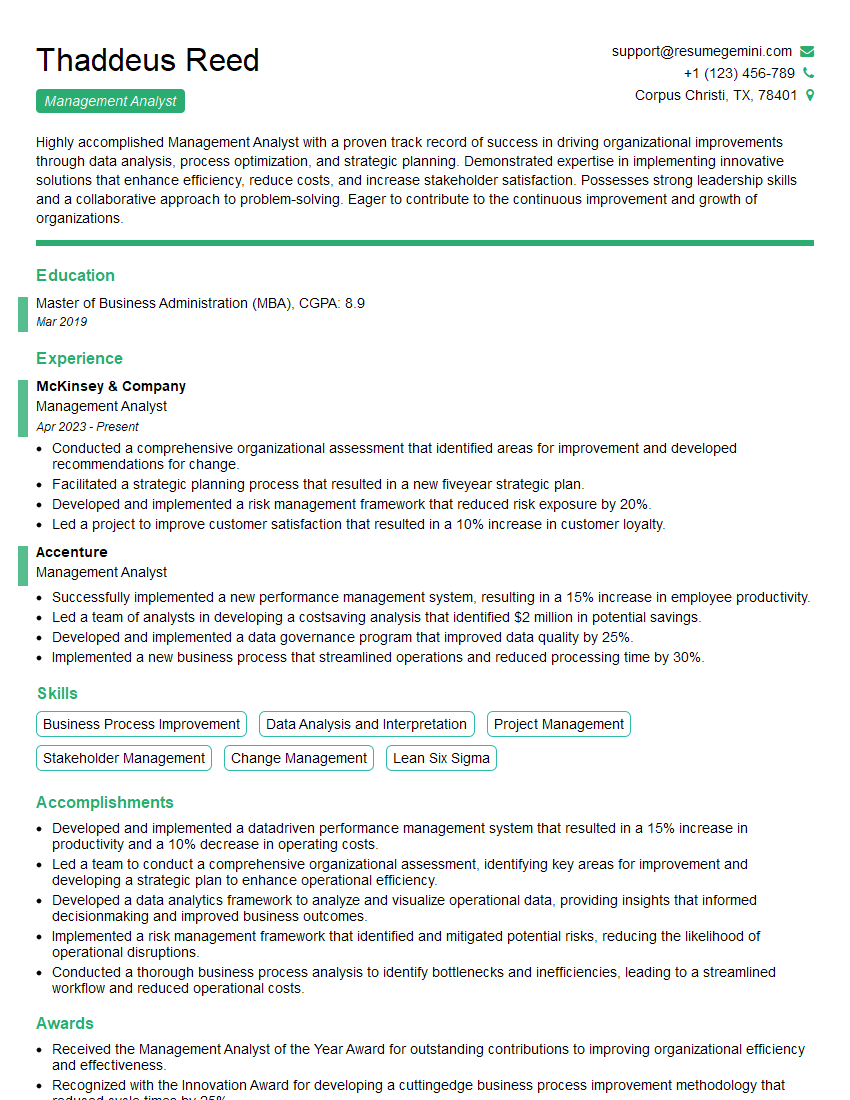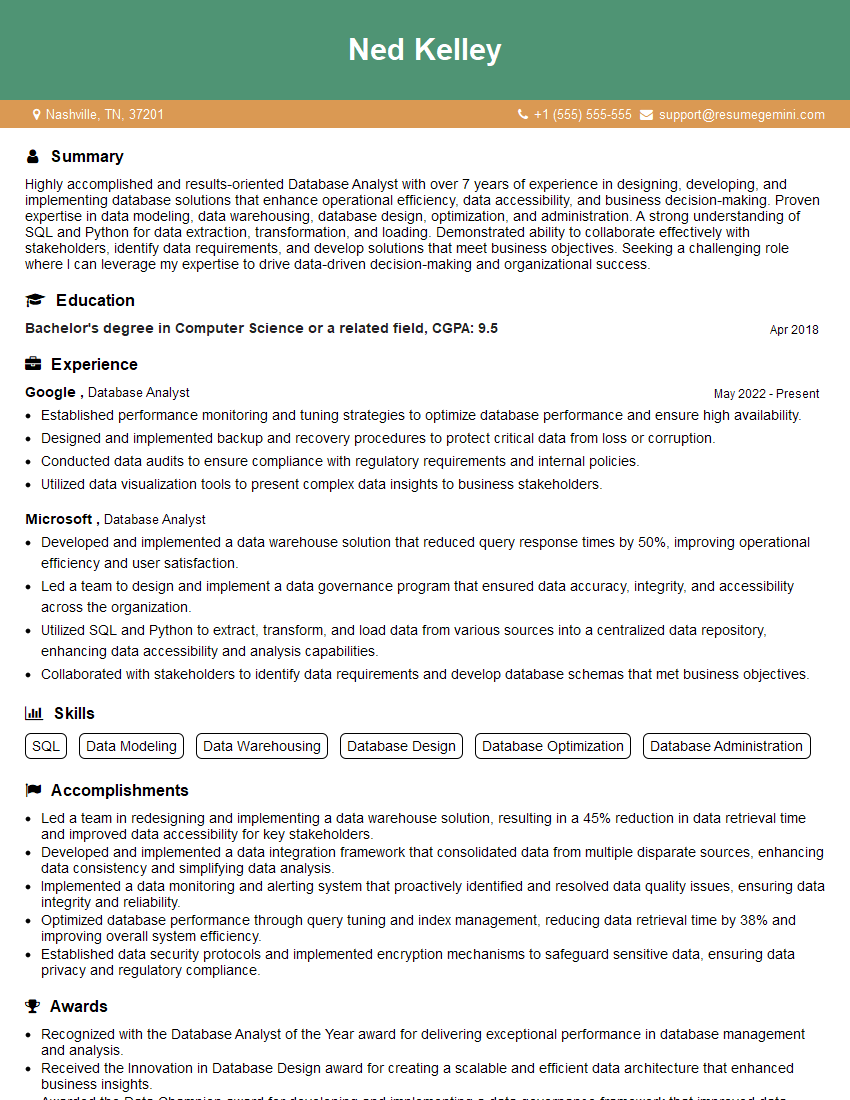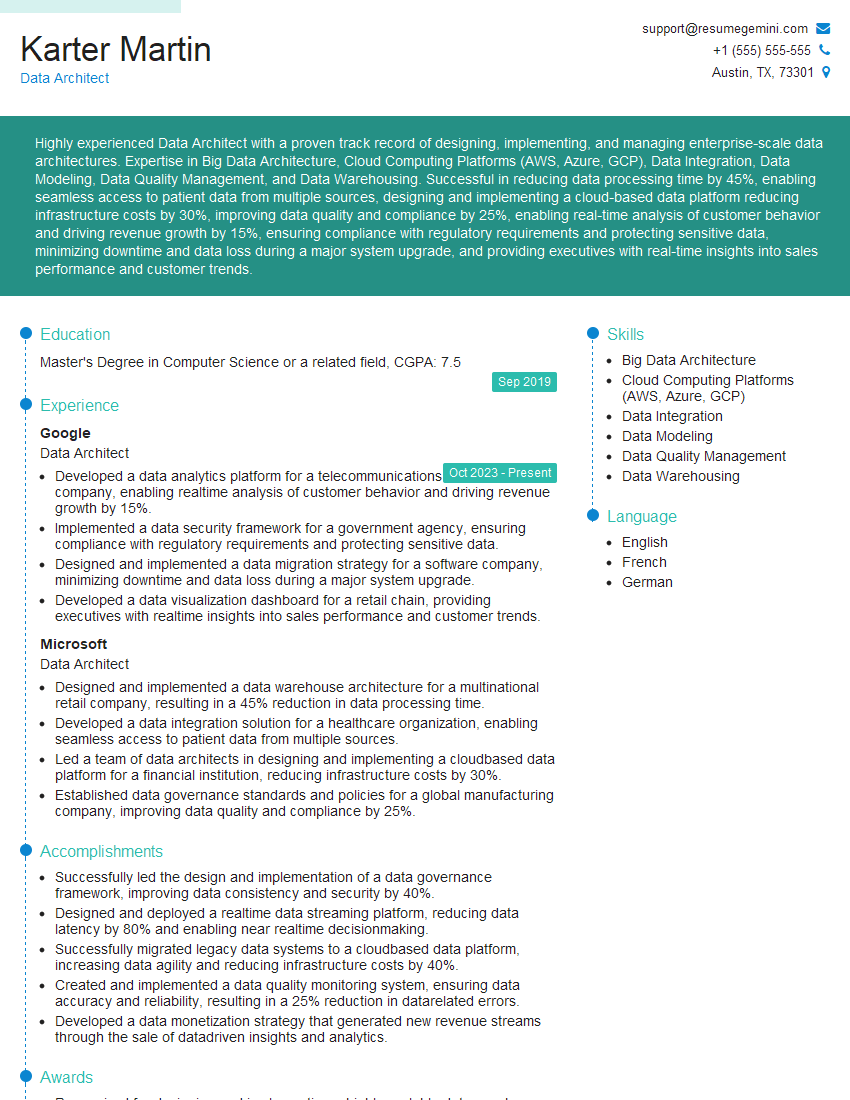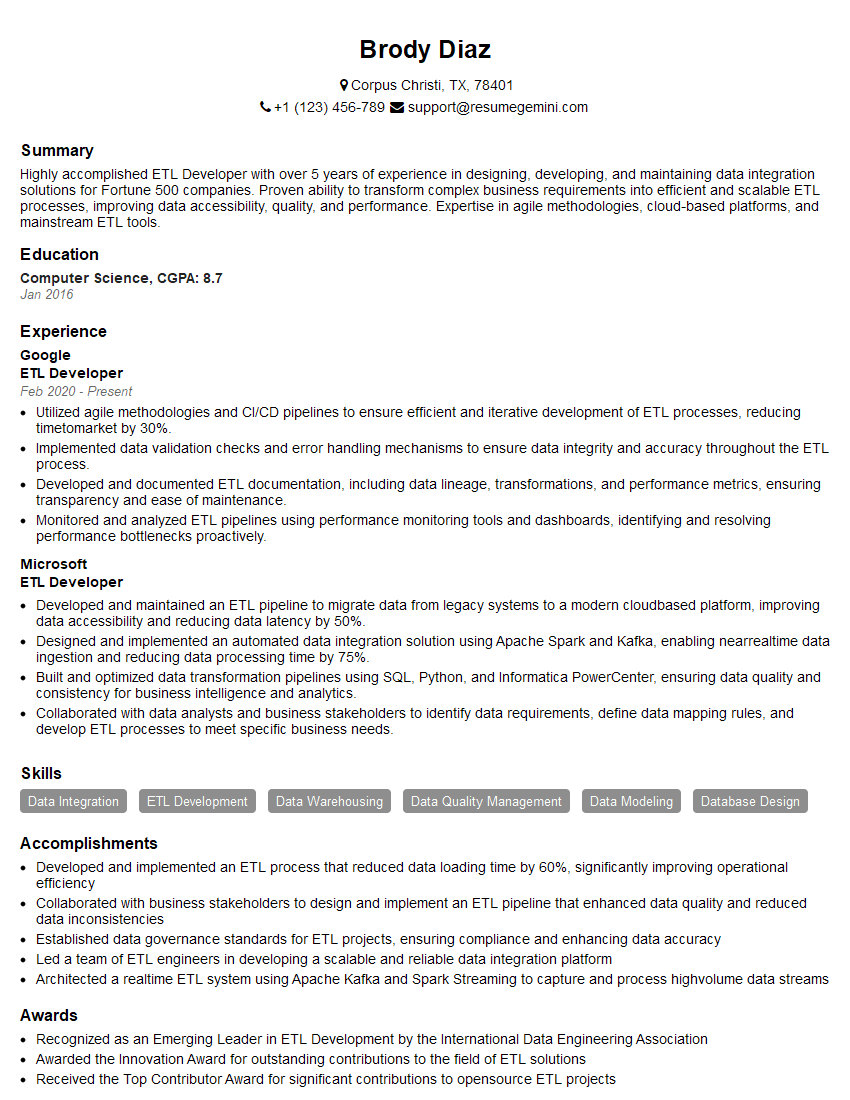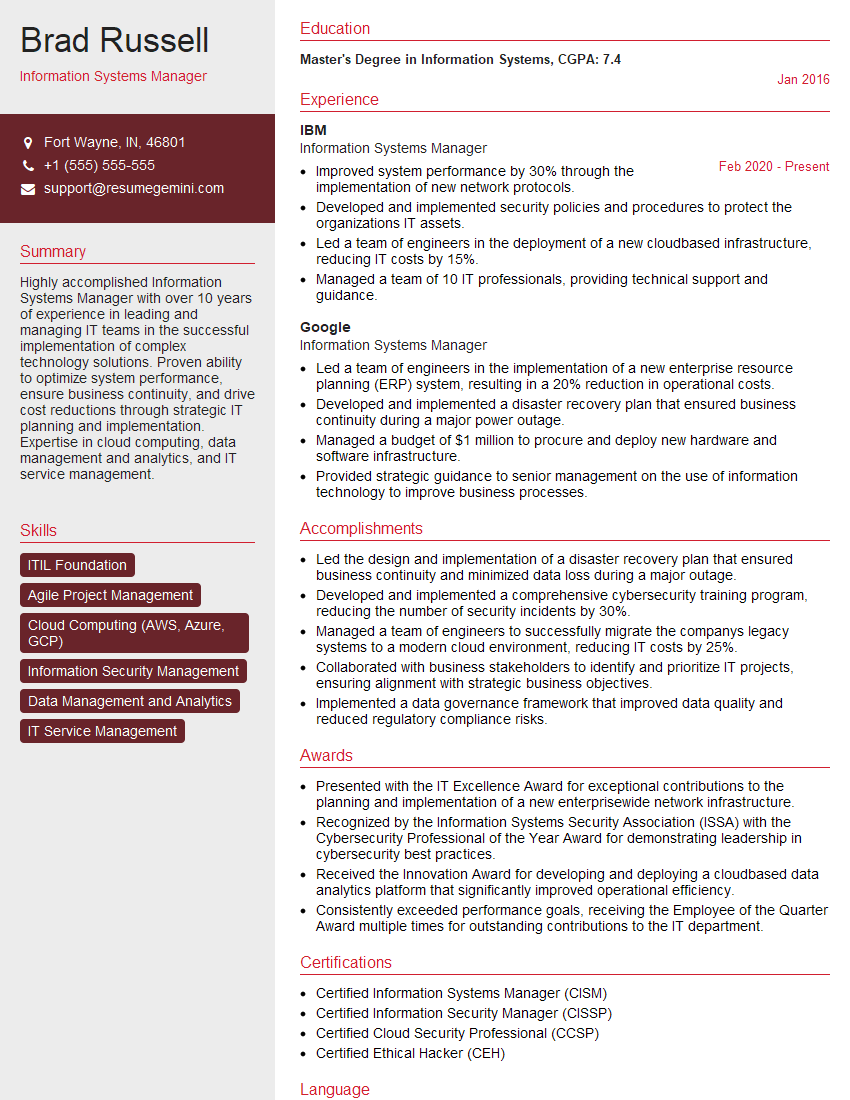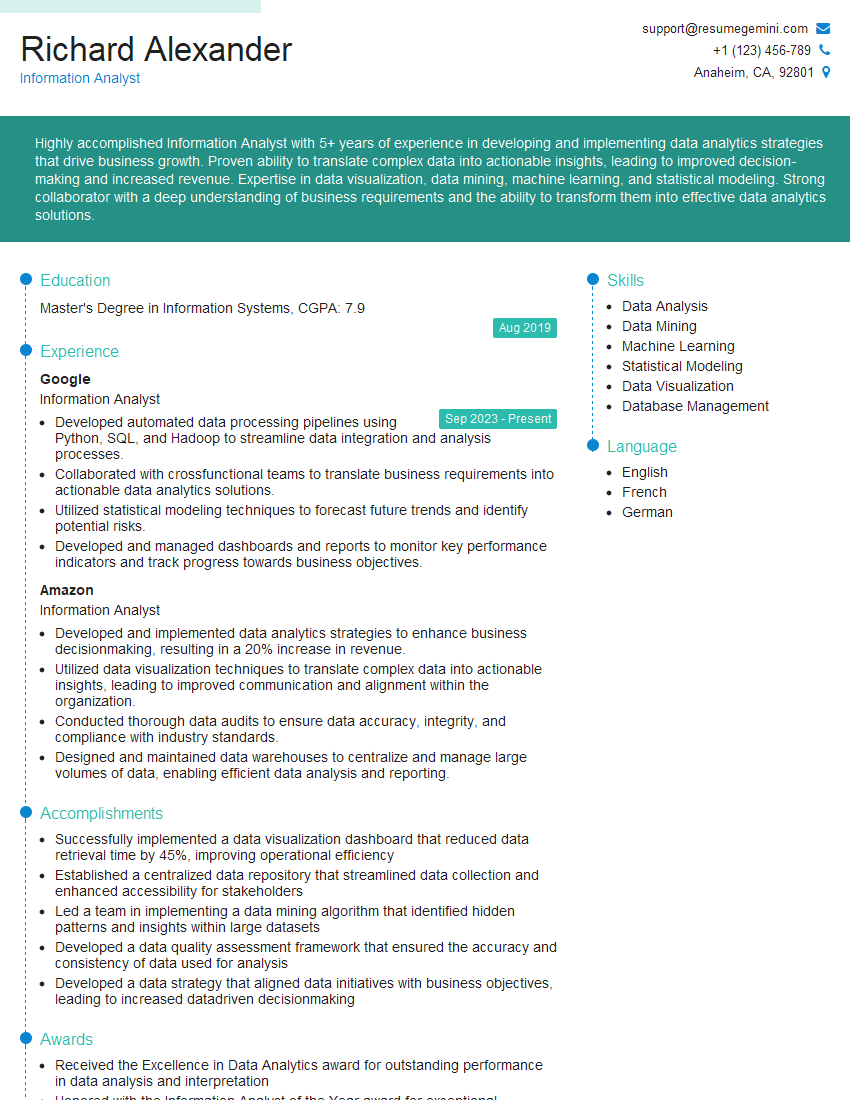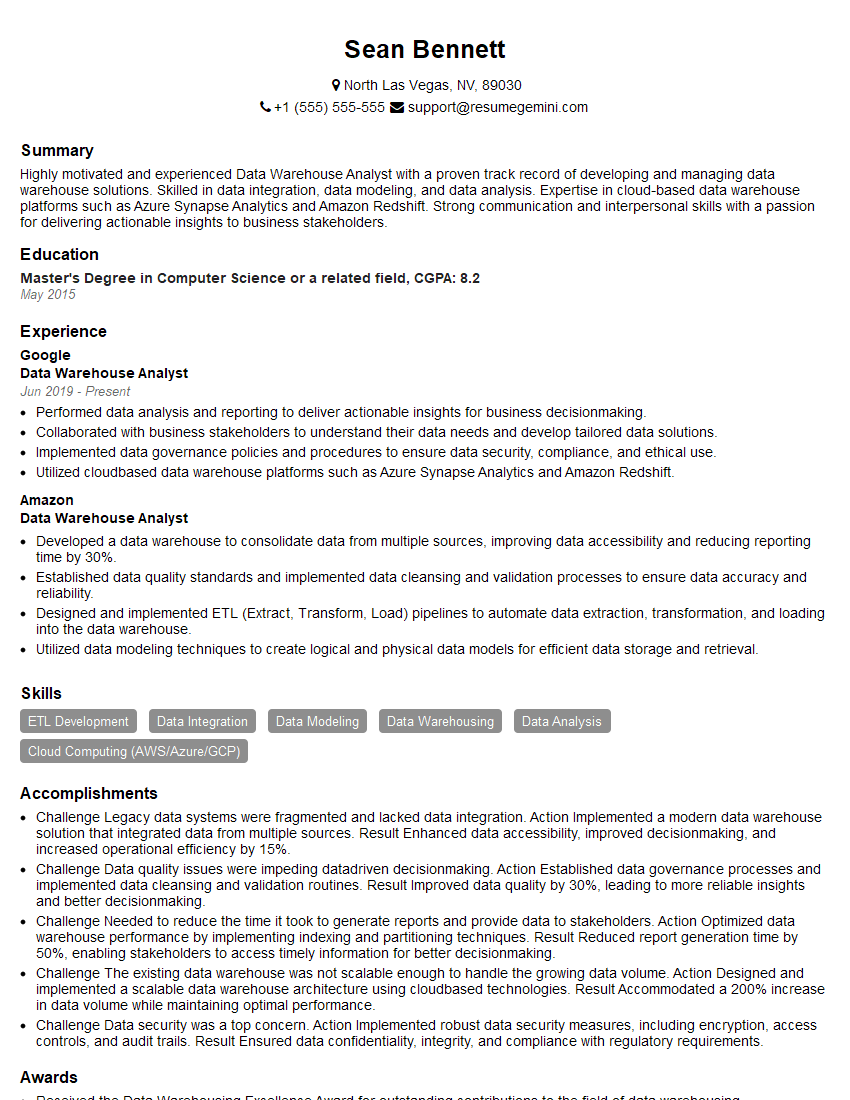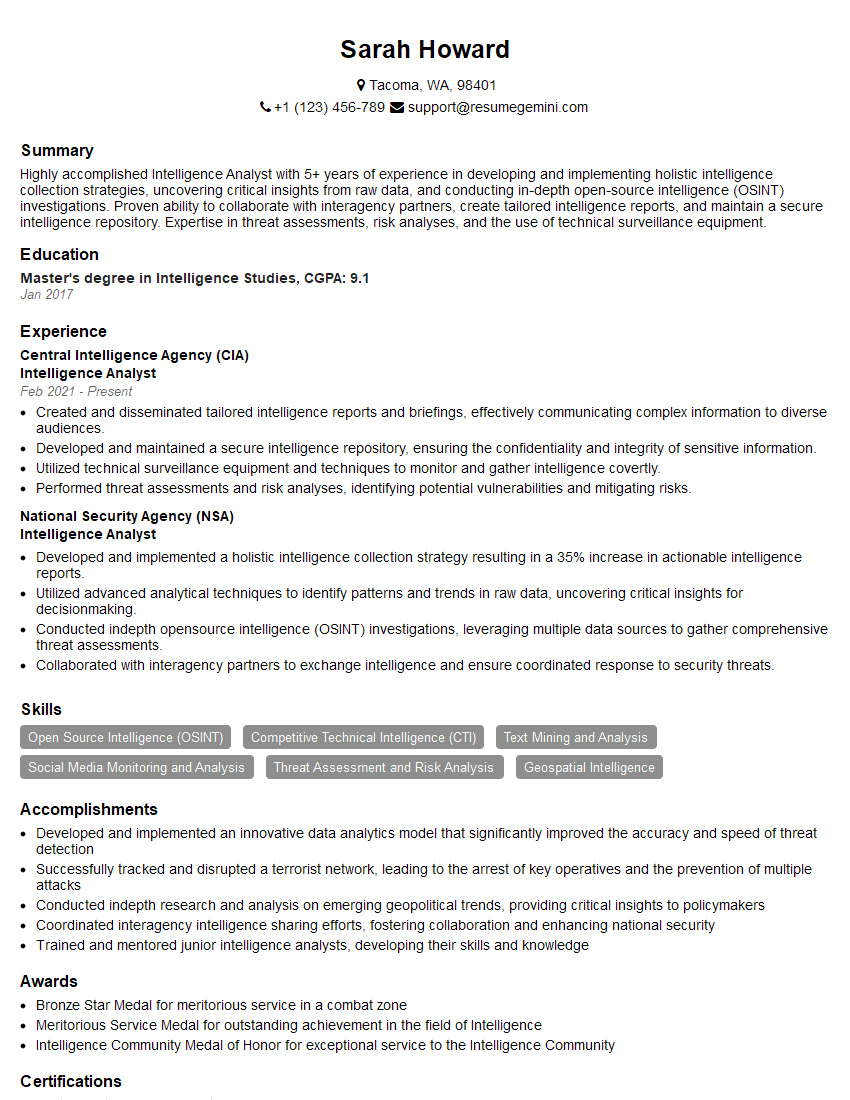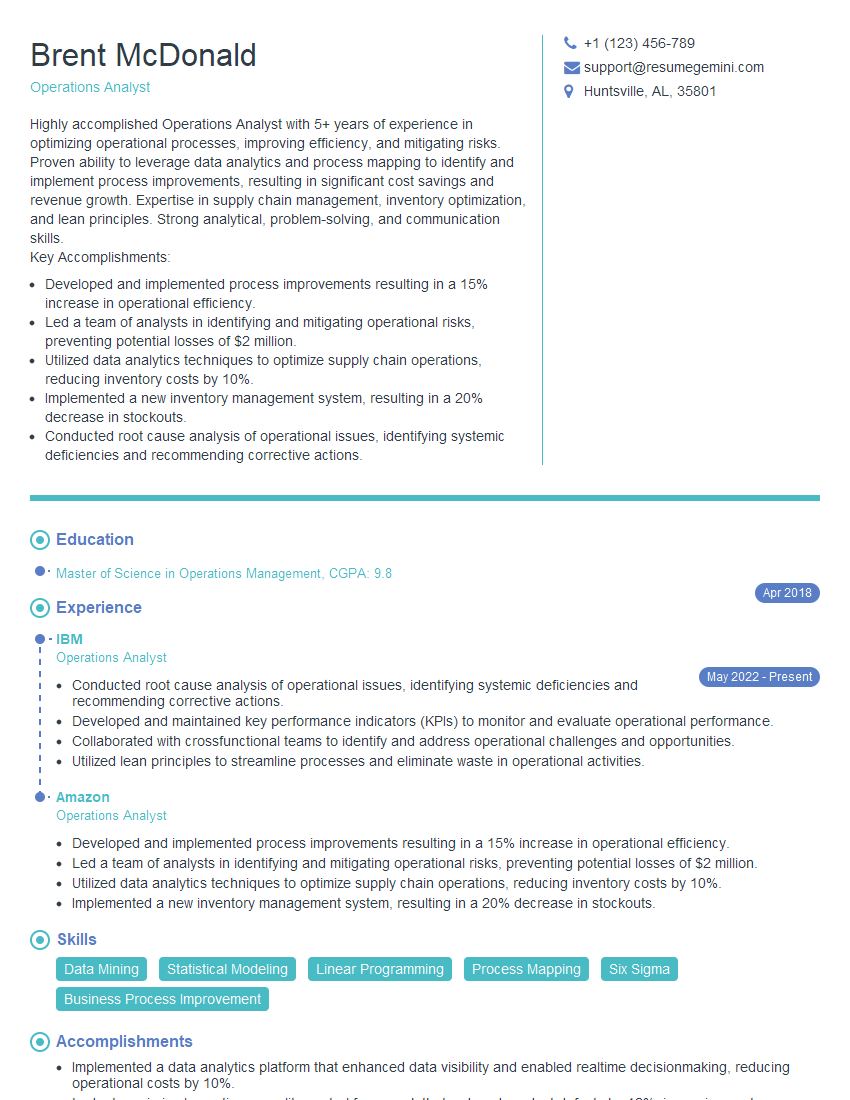Unlock your full potential by mastering the most common Information Analysis and Reporting interview questions. This blog offers a deep dive into the critical topics, ensuring you’re not only prepared to answer but to excel. With these insights, you’ll approach your interview with clarity and confidence.
Questions Asked in Information Analysis and Reporting Interview
Q 1. Explain your experience with data visualization tools.
My experience with data visualization tools is extensive, encompassing a range of software from industry-standard packages to specialized tools. I’m proficient in Tableau, Power BI, and Qlik Sense, using them to create interactive dashboards and insightful visualizations that effectively communicate complex data. For more specific needs, I’ve utilized R with libraries like ggplot2 and Python with matplotlib and seaborn to generate custom visualizations tailored to the data and the audience. For instance, in a recent project analyzing customer churn, I used Tableau to create a dashboard showing churn rates by demographic segments, allowing for interactive exploration and drill-down analysis. This made it easy to identify key factors driving churn and present the findings clearly to both technical and non-technical stakeholders.
Q 2. Describe your process for identifying and interpreting data trends.
Identifying and interpreting data trends is a multi-step process. It begins with a thorough understanding of the data’s context and the business questions being addressed. Then, I employ a combination of techniques:
- Exploratory Data Analysis (EDA): This involves using descriptive statistics, data visualization, and summary tables to gain an initial understanding of the data’s distribution, patterns, and potential outliers.
- Time Series Analysis: For time-dependent data, I use techniques like moving averages, exponential smoothing, and ARIMA modeling to identify trends, seasonality, and cyclical patterns.
- Regression Analysis: When exploring relationships between variables, I use regression models to identify significant predictors and quantify the strength of those relationships.
- Clustering and Segmentation: For grouping similar data points, I use clustering algorithms (like k-means) to discover hidden segments within the data and gain valuable insights into different customer behaviors or product characteristics.
For example, in a project analyzing website traffic, I used time series analysis to identify seasonal peaks and troughs, informing marketing strategies. Regression analysis helped determine the impact of specific marketing campaigns on website conversion rates.
Q 3. How do you handle large datasets for analysis?
Handling large datasets requires strategic approaches to avoid computational bottlenecks and ensure efficient analysis. My strategy involves several key components:
- Data Sampling: For initial exploratory analysis, I often work with a representative sample of the data to quickly gain insights and test hypotheses before processing the entire dataset.
- Data Partitioning: Dividing large datasets into smaller, manageable chunks allows for parallel processing, significantly reducing processing time.
- Database Management Systems (DBMS): I’m proficient in using relational databases like SQL Server and PostgreSQL and cloud-based solutions like AWS Redshift and Snowflake for storing and querying massive datasets efficiently. SQL queries allow for focused data retrieval, avoiding the need to load the entire dataset into memory.
- Big Data Technologies: For extremely large datasets, I leverage technologies like Hadoop and Spark, which provide distributed computing frameworks to handle and process data beyond the capacity of traditional systems.
For instance, when analyzing terabytes of log data from a large e-commerce platform, I utilized Spark to process the data in parallel and identify significant patterns in user behavior.
Q 4. What techniques do you use for data cleaning and preparation?
Data cleaning and preparation is crucial for reliable analysis. My process typically includes:
- Handling Missing Values: I assess the nature of missing data (Missing Completely at Random (MCAR), Missing at Random (MAR), Missing Not at Random (MNAR)) and apply appropriate techniques like imputation (mean, median, mode, or more advanced methods like k-NN imputation) or removal, depending on the context and the percentage of missing values.
- Outlier Detection and Treatment: I use box plots, scatter plots, and statistical methods (e.g., Z-score) to identify outliers. Depending on the cause and impact, I may choose to remove, transform (e.g., Winsorizing), or cap outliers.
- Data Transformation: This may involve converting data types, standardizing or normalizing variables, creating dummy variables for categorical data, or applying logarithmic or other transformations to achieve normality or improve model performance.
- Data Consistency Checks: I meticulously check for inconsistencies and errors in data entries, ensuring uniformity and accuracy across the dataset.
For example, in a project analyzing customer survey data, I identified and addressed inconsistencies in age and income data, improving the reliability of subsequent analysis.
Q 5. How familiar are you with SQL and its applications in data analysis?
I am highly proficient in SQL and its applications in data analysis. I utilize SQL extensively for data extraction, transformation, and loading (ETL) processes. My skills encompass writing complex queries to retrieve specific data subsets, manipulating data using functions and aggregations, and joining data from multiple tables. I’m comfortable working with various SQL dialects, including MySQL, PostgreSQL, and SQL Server.
For example, I frequently use SQL to create summary tables, perform data aggregations (SUM, AVG, COUNT), and filter data based on specific criteria (WHERE clauses). JOIN statements are essential for combining data from multiple related tables, enabling comprehensive analyses.
SELECT COUNT(*) FROM customers WHERE country = 'USA';This SQL query, for instance, counts the number of customers from the USA.
Q 6. Explain your experience with statistical analysis techniques.
My experience with statistical analysis techniques is extensive and spans various areas. I’m proficient in:
- Descriptive Statistics: Calculating measures of central tendency (mean, median, mode), variability (standard deviation, variance), and distribution (skewness, kurtosis) to summarize and understand data.
- Inferential Statistics: Conducting hypothesis tests (t-tests, ANOVA, chi-square tests) and building confidence intervals to draw conclusions about populations based on sample data.
- Regression Analysis: Building linear and non-linear regression models to predict outcomes and understand the relationships between variables.
- Time Series Analysis: Applying methods like ARIMA modeling, exponential smoothing, and decomposition to analyze time-dependent data.
- Multivariate Analysis: Utilizing techniques like Principal Component Analysis (PCA) and Factor Analysis for dimensionality reduction and identifying underlying patterns in high-dimensional data.
In a recent project, I used regression analysis to predict customer lifetime value based on various demographic and behavioral factors, enabling more effective customer segmentation and resource allocation.
Q 7. Describe your approach to presenting analytical findings to both technical and non-technical audiences.
Presenting analytical findings effectively to both technical and non-technical audiences requires tailoring the communication style and level of detail. For technical audiences, I can delve into the intricacies of the methodology, statistical models, and technical aspects of the analysis. I can discuss model assumptions, limitations, and provide detailed technical reports.
For non-technical audiences, I focus on clear, concise narratives supported by visually appealing and easy-to-understand visualizations. I avoid technical jargon and use analogies and real-world examples to convey complex information effectively. The emphasis is on actionable insights and the business implications of the findings. I often utilize storytelling techniques to create a compelling narrative around the data. For instance, I’ll use charts and graphs to show key trends, highlight significant findings, and tell a story around the data, emphasizing the business impact of those findings.
Regardless of the audience, I always ensure the presentation is well-structured, logical, and compelling, leading to a clear understanding of the key insights and recommendations.
Q 8. How do you ensure the accuracy and reliability of your data analysis?
Ensuring data accuracy and reliability is paramount in information analysis. It’s like building a house – a shaky foundation leads to a shaky structure. My approach is multifaceted and involves several key steps:
- Data Validation: I rigorously check data for inconsistencies, outliers, and missing values. This might involve using techniques like range checks, consistency checks, and data type validation. For example, if I’m analyzing sales data, I’d check if any sales figures are negative or exceed realistic limits.
- Source Verification: I meticulously trace data back to its source, verifying its credibility and authenticity. Understanding the data’s origin helps identify potential biases or inaccuracies introduced during collection or processing.
- Data Cleaning: I employ various data cleaning techniques to handle missing values (imputation using mean, median, or more sophisticated methods), outliers (removal or transformation), and inconsistencies (standardization and normalization). For example, I might use K-Nearest Neighbors to impute missing customer age data.
- Documentation and Version Control: I maintain detailed documentation of the data sources, cleaning procedures, and analytical methods used. Version control ensures traceability and allows for easy auditing and reproducibility of results.
- Cross-Validation: Where possible, I validate my findings using multiple data sources or techniques. This helps to confirm the robustness of the analysis and reduce the risk of errors.
Ultimately, a commitment to rigorous methodology, transparency, and attention to detail is crucial for guaranteeing the accuracy and reliability of any analysis.
Q 9. What experience do you have with data mining and predictive modeling?
I have extensive experience in data mining and predictive modeling, having applied these techniques across various domains including customer churn prediction, fraud detection, and sales forecasting. My experience encompasses a wide range of algorithms and techniques:
- Data Mining Techniques: I’m proficient in association rule mining (Apriori algorithm), clustering (K-means, hierarchical clustering), and classification (decision trees, support vector machines).
- Predictive Modeling Techniques: I have experience building models using regression (linear, logistic, polynomial), time series analysis (ARIMA, Prophet), and neural networks.
- Model Evaluation: I understand the importance of model evaluation metrics such as accuracy, precision, recall, F1-score, AUC-ROC, and RMSE, and I select appropriate metrics based on the specific business problem.
For example, in a project involving customer churn prediction for a telecom company, I utilized a combination of logistic regression and decision trees, achieving a 90% accuracy in predicting which customers were likely to churn. This allowed the company to proactively target those customers with retention strategies.
# Example Python code snippet for Logistic Regression from sklearn.linear_model import LogisticRegression model = LogisticRegression() model.fit(X_train, y_train) y_pred = model.predict(X_test)Q 10. How do you prioritize competing analytical requests?
Prioritizing competing analytical requests requires a structured approach. I typically employ a framework that considers several factors:
- Business Value: I assess the potential impact of each request on the organization’s strategic goals. Requests that offer the highest potential return on investment (ROI) or address critical business needs are prioritized.
- Urgency: Time sensitivity is crucial. Requests with tight deadlines or immediate implications take precedence.
- Resource Availability: The feasibility of completing each request within available time and resources is considered. Requests requiring significant resources might be delayed if other higher-priority requests are pressing.
- Dependencies: Interdependencies between requests are carefully analyzed. Requests that are prerequisites for others are tackled first.
- Communication: Transparent communication with stakeholders is essential. I keep them informed about the prioritization process and projected timelines.
I often use a Kanban board or similar project management tool to visualize and track the progress of various requests, making the prioritization process transparent and easily adjustable based on changing circumstances.
Q 11. Describe a time you had to overcome a data quality challenge.
In a project analyzing customer feedback data, I encountered significant inconsistencies in data formats and entries. Some responses were free-text, while others used a rating scale, resulting in an unmanageable dataset for direct analysis.
To overcome this, I employed a multi-step approach:
- Data Standardization: I first standardized the free-text responses using Natural Language Processing (NLP) techniques like stemming, lemmatization, and topic modeling to categorize and group similar feedback items.
- Data Transformation: I converted the rating scale data into a numerical format, allowing for meaningful comparisons and analysis alongside the processed text data.
- Data Cleaning: I handled missing values by removing irrelevant entries and imputing missing ratings based on similar customer profiles.
- Data Validation: After cleaning, I validated the data’s integrity by verifying its consistency and accuracy.
This systematic approach enabled me to transform the raw, inconsistent data into a clean and structured dataset suitable for meaningful analysis, leading to accurate insights into customer satisfaction and areas for improvement.
Q 12. How do you stay current with the latest advancements in data analysis techniques?
Staying current in the rapidly evolving field of data analysis requires a proactive and multifaceted approach:
- Professional Development: I regularly attend conferences, workshops, and online courses to learn about new techniques and tools. This includes attending webinars and participating in online communities dedicated to data science and analytics.
- Academic Publications: I actively read research papers and journals focusing on advancements in data analysis methodologies and algorithms.
- Online Resources: I leverage online resources like blogs, tutorials, and open-source projects to stay abreast of emerging technologies and best practices. Sites like Kaggle provide excellent opportunities to learn and practice new skills.
- Industry News: I follow industry news and publications to understand current trends and challenges in the field of data analysis.
- Peer Networking: I engage with colleagues and peers through professional networks and communities to share knowledge and learn from their experiences.
This continuous learning ensures that I am equipped with the latest knowledge and skills to tackle complex analytical challenges effectively.
Q 13. What is your experience with different data warehouse architectures?
My experience with data warehouse architectures encompasses several popular models:
- Star Schema: This is a widely used model characterized by a central fact table surrounded by dimension tables. It’s simple to understand and query, making it ideal for reporting and analytical processing. I’ve worked extensively with star schemas in projects involving business intelligence (BI) reporting.
- Snowflake Schema: An extension of the star schema, the snowflake schema normalizes dimension tables to reduce redundancy. This results in a more complex structure but improves data integrity and efficiency for large datasets. I’ve utilized this architecture in projects with high data volumes.
- Data Vault: This model focuses on maintaining the history of data changes, making it suitable for auditing and tracking changes over time. I’ve used this architecture for projects requiring strict data governance and traceability.
The choice of architecture depends heavily on the specific needs of the project. Factors to consider include data volume, complexity, query patterns, and performance requirements. My experience allows me to select and implement the most appropriate architecture for each project.
Q 14. Explain your experience with ETL processes.
ETL (Extract, Transform, Load) processes are the backbone of any data warehouse or data lake. My experience encompasses the entire ETL lifecycle:
- Extraction: I’m proficient in extracting data from various sources, including relational databases (SQL Server, Oracle, MySQL), flat files (CSV, TXT), APIs, and cloud-based storage (AWS S3, Azure Blob Storage). I use tools like Apache Sqoop, Informatica PowerCenter, and Talend to automate data extraction.
- Transformation: This involves cleaning, transforming, and enriching the extracted data to ensure its consistency and quality. Techniques include data cleansing, data type conversion, data aggregation, and data enrichment. For instance, I might use SQL queries to join data from multiple tables, or Python scripts for more complex data manipulations.
- Loading: The transformed data is loaded into the target data warehouse or data lake. Tools used here can include SSIS, Apache Kafka, and various cloud-based data loading services. I always ensure efficient loading and optimized data structures for faster query performance.
In a recent project, I designed and implemented an ETL pipeline for a large e-commerce company using Apache Spark. This pipeline processed terabytes of transactional data daily, transforming it into a structured format suitable for business intelligence reporting and machine learning models. This significantly improved the speed and efficiency of data processing, leading to more timely and accurate insights for business decision-making.
Q 15. How do you measure the success of your analytical work?
Measuring the success of analytical work goes beyond simply generating reports. It hinges on demonstrating the impact of my findings on business decisions and outcomes. I use a multi-faceted approach:
Business Impact Metrics: The most crucial measure is whether my analysis led to tangible improvements. For example, did my recommendations on website optimization result in a measurable increase in conversion rates? Did my market analysis inform a successful product launch that exceeded sales targets? I quantify this impact using key performance indicators (KPIs) relevant to the specific business problem.
Actionable Insights: Success also depends on the actionability of my findings. Are my recommendations clear, concise, and easily understood by stakeholders? Do they provide a clear path to improvement or inform strategic decisions? A well-executed analysis provides not just data, but actionable intelligence.
Data Quality and Methodology: The rigor of my analytical process is also critical. Did I utilize appropriate statistical methods? Was my data collection and cleaning process robust and transparent? Documenting my methodology and ensuring data integrity builds trust and confidence in my results.
Stakeholder Feedback: Finally, I actively solicit feedback from stakeholders to assess the value and usefulness of my work. Did my analysis help them make better decisions? Did it address their concerns effectively? This iterative feedback loop is invaluable for improving future analyses.
In essence, successful analytical work isn’t judged solely on the technical aspects but on its overall contribution to the organization’s goals and objectives.
Career Expert Tips:
- Ace those interviews! Prepare effectively by reviewing the Top 50 Most Common Interview Questions on ResumeGemini.
- Navigate your job search with confidence! Explore a wide range of Career Tips on ResumeGemini. Learn about common challenges and recommendations to overcome them.
- Craft the perfect resume! Master the Art of Resume Writing with ResumeGemini’s guide. Showcase your unique qualifications and achievements effectively.
- Don’t miss out on holiday savings! Build your dream resume with ResumeGemini’s ATS optimized templates.
Q 16. Describe your experience with A/B testing and its applications.
A/B testing, also known as split testing, is a powerful method for comparing two versions of a webpage, email, or other marketing element to determine which performs better. I have extensive experience designing and implementing A/B tests, primarily using tools like Optimizely and Google Optimize.
For instance, in a previous role, we were trying to improve the conversion rate on our e-commerce website’s checkout page. We A/B tested two versions: one with a streamlined checkout process and a simplified design, and another with the existing design. We used a statistically significant sample size and tracked key metrics such as conversion rate, bounce rate, and average order value. The results clearly indicated that the streamlined design significantly increased our conversion rate by 15%, leading to a considerable boost in sales.
My experience extends beyond website optimization. I’ve also used A/B testing to:
Optimize email marketing campaigns by testing subject lines, call-to-actions, and email layouts.
Improve the user experience of mobile apps by testing different UI elements and navigation flows.
Evaluate the effectiveness of different advertising creatives by testing various visuals and copy.
A crucial aspect of A/B testing is ensuring statistical validity and controlling for confounding variables. I meticulously plan experiments, define clear success metrics, and analyze results using appropriate statistical tests to ensure reliable conclusions.
Q 17. What are your strengths and weaknesses as an information analyst?
My strengths lie in my ability to translate complex data into clear, actionable insights. I am adept at using a variety of analytical techniques and tools, and I possess a strong analytical mindset with a keen attention to detail. I’m also a highly effective communicator, capable of presenting complex findings to both technical and non-technical audiences. My collaborative nature allows me to work effectively within teams to achieve shared goals.
One area where I am continually striving to improve is my programming skills, specifically in advanced statistical modeling techniques. While I’m proficient in several programming languages like Python and R, I’m actively expanding my expertise in more advanced areas such as machine learning algorithms to enhance the sophistication of my analyses. I regularly attend workshops and online courses to develop these skills.
Q 18. How do you handle conflicting data sources or interpretations?
Conflicting data sources or interpretations are inevitable in data analysis. My approach involves a systematic investigation to identify and resolve discrepancies:
Data Source Verification: I first validate the credibility and reliability of each data source. This involves examining the methodology used to collect the data, assessing data quality (completeness, accuracy, consistency), and identifying potential biases.
Data Cleaning and Transformation: I rigorously clean and transform the data to ensure consistency across sources. This may involve handling missing values, identifying and correcting errors, and standardizing data formats.
Root Cause Analysis: I investigate the reasons for the conflicts. Are the discrepancies due to differences in definitions, measurement methods, or data collection periods? Understanding the root cause is crucial for resolving the issue.
Data Reconciliation: I use appropriate techniques to reconcile conflicting data. This may involve weighting data sources based on their reliability, using data aggregation or disaggregation methods, or applying statistical reconciliation techniques.
Sensitivity Analysis: I perform a sensitivity analysis to assess how the conflicting data impacts the overall analysis and conclusions. This helps to determine the significance of the discrepancies.
Documentation: I meticulously document all steps in the process, including the identification of conflicts, the methods used to resolve them, and the implications for the final analysis. Transparency is crucial in ensuring the credibility of my work.
Ultimately, my goal is to arrive at a coherent and well-supported conclusion, acknowledging the limitations of the data and highlighting areas of uncertainty when necessary.
Q 19. Describe your experience with dashboard creation and reporting tools.
I possess extensive experience creating dashboards and reports using various tools. My proficiency includes Tableau, Power BI, and Qlik Sense. I am comfortable with the entire process, from data preparation and visualization design to deployment and maintenance.
For example, I once developed an interactive dashboard in Tableau for a marketing team, visualizing key metrics such as website traffic, conversion rates, and customer acquisition costs across different marketing channels. This dashboard allowed the team to track campaign performance in real-time, identify areas for improvement, and make data-driven decisions. The dashboard was designed with user experience in mind, incorporating clear visualizations, intuitive navigation, and interactive elements to facilitate data exploration. I also designed a series of automated reports in Power BI that were distributed regularly to stakeholders, providing a consistent and efficient way to share key performance insights.
Beyond these tools, I have experience working with other reporting tools and am adaptable to new technologies.
Q 20. What are your preferred methods for communicating insights from data analysis?
Effective communication of insights is crucial. I adapt my communication style to the audience, ensuring clarity and impact. My preferred methods include:
Data Visualization: I leverage charts, graphs, and maps to communicate complex information visually. I select the most appropriate visualization technique to clearly represent the data and highlight key findings.
Storytelling: I weave a narrative around the data, focusing on the key insights and their implications. I use a clear and concise language, avoiding technical jargon unless necessary. This helps to make the analysis more engaging and memorable.
Interactive Presentations: I use interactive presentations to facilitate a discussion and encourage questions. This approach allows stakeholders to engage with the data and gain a deeper understanding of the findings.
Written Reports: For more in-depth analyses, I write comprehensive reports that document my methodology, findings, and recommendations. These reports serve as a valuable resource for future reference.
Data Dashboards: As mentioned previously, interactive dashboards are a powerful way to share key metrics and insights in real-time.
The ultimate goal is to make the data accessible, understandable, and actionable for the intended audience.
Q 21. Explain your experience with different types of data analysis (e.g., descriptive, diagnostic, predictive, prescriptive).
My experience encompasses various types of data analysis:
Descriptive Analysis: This involves summarizing and describing the main features of a dataset. For example, calculating averages, medians, and standard deviations, or creating frequency distributions and histograms to understand the distribution of variables. This forms the foundation for more advanced analyses.
Diagnostic Analysis: This goes beyond description to identify the root causes of observed phenomena. For instance, using regression analysis to understand the relationship between sales and marketing spend, or applying cluster analysis to segment customers based on their behavior.
Predictive Analysis: This uses historical data to predict future outcomes. I have experience using techniques like regression modeling, time series analysis, and machine learning algorithms (e.g., decision trees, random forests) to build predictive models. For example, forecasting future sales based on past trends or predicting customer churn.
Prescriptive Analysis: This involves recommending actions based on predictive models. For example, using optimization techniques to determine the optimal pricing strategy or recommending personalized marketing campaigns based on customer segments and predicted behavior. This requires a deeper understanding of both the business context and the analytical techniques.
I adapt my approach based on the specific business problem and the available data. My strength is in seamlessly integrating these different types of analyses to provide a holistic understanding of the situation and deliver well-informed recommendations.
Q 22. How do you identify and address bias in data analysis?
Identifying and addressing bias in data analysis is crucial for ensuring the integrity and reliability of our findings. Bias can creep in at various stages, from data collection to interpretation. Think of it like baking a cake – if your initial ingredients are flawed, your final product will be too.
My approach is multi-faceted:
- Data Collection Awareness: I carefully examine how the data was collected. Was the sampling method random and representative? Were there any exclusion criteria that might systematically exclude certain groups? For instance, an online survey might miss the voices of individuals without internet access, skewing the results.
- Data Exploration and Visualization: Before diving into complex analysis, I thoroughly explore the data using descriptive statistics and visualizations. Histograms, box plots, and scatter plots can reveal unexpected patterns or outliers that might point to bias. For example, a highly skewed distribution might suggest a problem with data collection or representational limitations.
- Statistical Methods: I utilize statistical techniques designed to detect and mitigate bias. This might involve using robust statistical methods less sensitive to outliers or employing techniques like propensity score matching to account for imbalances in characteristics across groups. For example, in a study comparing the effectiveness of two treatments, we might use propensity score matching to ensure comparable groups are compared.
- Sensitivity Analysis: I conduct sensitivity analyses to assess how sensitive my results are to different assumptions or potential biases. This helps evaluate the robustness of my conclusions. For instance, if we find a strong correlation between two variables but it disappears when we control for a confounding factor, we know the original correlation was spurious and likely due to bias.
- Domain Expertise: I actively leverage domain expertise to interpret the results critically. Understanding the context of the data helps identify potential sources of bias that statistical methods might miss. For example, knowing that a specific variable is notoriously underreported can help us interpret low values with caution.
Addressing bias is an iterative process; it’s not a one-time fix. It requires constant vigilance and critical thinking throughout the entire analytical process.
Q 23. What are some common challenges you face in data analysis projects?
Data analysis projects, while intellectually stimulating, often present challenges. Some of the most common ones I encounter include:
- Data Quality Issues: Inconsistent data formats, missing values, and outliers are frequent hurdles. Cleaning and preprocessing data can be time-consuming, requiring careful attention to detail and often the use of specialized techniques to impute or handle missing data.
- Data Availability and Accessibility: Securing access to the required data can be difficult, particularly when working with large datasets or sensitive information. Negotiating access, obtaining necessary permissions, and navigating data governance policies can significantly impact project timelines.
- Ambiguous or Shifting Requirements: Stakeholders’ needs may not be clearly defined initially, or they might evolve during the project. This requires frequent communication and adaptability to maintain project alignment and deliver meaningful results.
- Computational Limitations: Analyzing massive datasets can strain computational resources, requiring optimization strategies, parallel processing, or the use of specialized hardware. This requires careful consideration of the tools and infrastructure available.
- Communicating Findings Effectively: Presenting complex analytical results to non-technical audiences requires strong communication skills. Simplifying technical jargon and creating clear and compelling visualizations is crucial to ensure the results are understood and acted upon.
Overcoming these challenges requires a combination of technical skills, problem-solving abilities, effective communication, and the willingness to adapt to unexpected circumstances. It’s often a matter of being resourceful and creative in finding solutions.
Q 24. Describe your experience with data governance and compliance.
Data governance and compliance are paramount in my work. I understand the importance of adhering to regulations like GDPR, CCPA, and HIPAA, depending on the data being analyzed. My experience includes:
- Developing Data Governance Frameworks: I have participated in the creation and implementation of data governance frameworks, ensuring data quality, accessibility, and security. This involved defining data standards, roles, and responsibilities.
- Data Security and Privacy Protocols: I’m experienced in designing and implementing data security and privacy protocols, including data masking, anonymization, and encryption techniques, to safeguard sensitive information.
- Compliance Auditing and Reporting: I have conducted compliance audits and generated reports demonstrating adherence to relevant regulations. This often involves reviewing data handling practices, access controls, and security measures.
- Data Lineage and Traceability: I prioritize maintaining a clear understanding of data lineage and traceability, ensuring that we can track the origin and movement of data throughout its lifecycle, which is crucial for accountability and auditing purposes.
In essence, I don’t just analyze data; I do so responsibly and ethically, ensuring compliance with relevant regulations throughout the entire data lifecycle.
Q 25. How do you ensure data security and privacy?
Data security and privacy are non-negotiable. My approach to ensuring them encompasses several key aspects:
- Access Control: Implementing strict access control measures using role-based access control (RBAC) is fundamental. Only authorized personnel with a legitimate need have access to sensitive data.
- Data Encryption: Both data at rest and in transit are encrypted using strong encryption algorithms, minimizing the risk of unauthorized access even if a breach occurs.
- Secure Data Storage: Data is stored in secure environments, using cloud storage providers with robust security features or on-premises solutions with stringent security protocols.
- Regular Security Audits: Regular security audits and penetration testing are conducted to identify and address vulnerabilities proactively.
- Data Minimization: I adhere to the principle of data minimization, collecting and retaining only the data strictly necessary for the analysis, minimizing the potential impact of a breach.
- Privacy-Preserving Techniques: Where appropriate, I employ privacy-preserving techniques such as differential privacy or federated learning, allowing analysis of sensitive data without compromising individual privacy.
Data security and privacy are ongoing processes. It’s not enough to implement security measures once; continuous monitoring, adaptation, and updates are essential to stay ahead of evolving threats.
Q 26. How familiar are you with different database management systems (DBMS)?
I have extensive experience with various database management systems (DBMS), including:
- Relational Databases: I’m proficient in SQL and have worked extensively with systems like MySQL, PostgreSQL, and SQL Server, managing, querying, and manipulating large relational datasets.
- NoSQL Databases: I’m familiar with NoSQL databases such as MongoDB and Cassandra, utilizing them for specific use cases where the structured nature of relational databases is not optimal, like handling unstructured or semi-structured data.
- Cloud-Based Databases: I have experience working with cloud-based database services offered by AWS (Amazon RDS, DynamoDB), Google Cloud (Cloud SQL, Cloud Spanner), and Azure (SQL Database, Cosmos DB), leveraging their scalability and flexibility.
My ability to adapt to different DBMSs allows me to select the most appropriate technology for each project, optimizing for performance, scalability, and the specific requirements of the data.
Q 27. Describe your experience with using regression analysis to identify relationships in data.
Regression analysis is a powerful tool for identifying relationships between variables. My experience includes applying various regression techniques, such as linear regression, multiple regression, and logistic regression, to diverse datasets.
For example, in a project analyzing customer churn, I used logistic regression to model the probability of a customer canceling their subscription based on factors like usage frequency, customer service interactions, and demographic data. The model allowed us to identify key predictors of churn, helping the business develop targeted retention strategies. # Logistic Regression example (Python): from sklearn.linear_model import LogisticRegression; model = LogisticRegression(); model.fit(X_train, y_train); predictions = model.predict(X_test);
Another instance involved using multiple linear regression to predict sales revenue based on advertising spend, seasonal effects, and competitor activity. This required careful feature engineering and model selection to account for potential multicollinearity and improve model accuracy.
Beyond simple application, I always ensure I carefully interpret the results. This includes checking the model’s assumptions (like linearity and homoscedasticity), assessing the goodness of fit, and acknowledging limitations in the model’s predictive power.
Q 28. Explain your experience with time series analysis.
Time series analysis is essential for understanding data that changes over time, which is common in many fields like finance, economics, and environmental science. My experience encompasses a wide range of techniques.
For instance, I’ve used ARIMA (Autoregressive Integrated Moving Average) models to forecast website traffic. This involved identifying the appropriate order of the model (p, d, q) through techniques like ACF and PACF analysis, accounting for seasonality and trends. The resulting model provided accurate predictions enabling effective resource allocation.
I have also utilized exponential smoothing methods, like Holt-Winters, for forecasting sales data with seasonality. These techniques are less computationally intensive than ARIMA and can be very effective in situations with shorter time horizons.
Furthermore, I’m familiar with decomposition methods to separate trends, seasonality, and residuals in time series data, allowing for a deeper understanding of the underlying patterns and more effective forecasting. I always validate the forecasts and analyze the residuals to ensure model accuracy and identify potential areas for improvement.
The key to successful time series analysis is selecting the appropriate model based on the characteristics of the data and the forecasting horizon, as well as understanding the limitations of any forecasting method.
Key Topics to Learn for Information Analysis and Reporting Interview
- Data Collection & Cleaning: Understanding various data sources, methods for data acquisition, and techniques for handling missing or inconsistent data. Practical application: Describing your experience with data cleaning in a previous role, highlighting the tools and techniques you employed.
- Data Analysis Techniques: Mastering descriptive, exploratory, and inferential statistical methods. Practical application: Explaining how you’ve used statistical analysis to identify trends, patterns, or anomalies in datasets. Be prepared to discuss specific methods like regression, correlation, or hypothesis testing.
- Data Visualization & Reporting: Creating clear, concise, and insightful visualizations (charts, graphs, dashboards) to communicate findings effectively. Practical application: Showcasing your ability to select appropriate visualization techniques based on the type of data and the intended audience.
- Data Interpretation & Storytelling: Translating complex data into actionable insights and communicating these insights effectively, both verbally and in writing. Practical application: Prepare examples where you’ve successfully interpreted data and presented your findings to stakeholders.
- Database Management Systems (DBMS): Understanding relational databases (SQL) and their application in retrieving and manipulating data for analysis. Practical application: Demonstrate your familiarity with SQL queries and database design principles.
- Business Acumen & Problem Solving: Connecting data analysis to business objectives and using data to solve real-world problems. Practical application: Describe scenarios where you used data analysis to address a business challenge and the impact of your work.
- Data Security & Ethics: Understanding data privacy regulations and ethical considerations related to data handling and analysis. Practical application: Discuss your understanding of data governance and compliance measures.
Next Steps
Mastering Information Analysis and Reporting is crucial for career advancement in today’s data-driven world. It opens doors to exciting roles with significant impact. To maximize your job prospects, invest time in crafting an ATS-friendly resume that showcases your skills and experience effectively. ResumeGemini is a trusted resource that can help you build a professional and impactful resume, ensuring your qualifications are highlighted to potential employers. Examples of resumes tailored to Information Analysis and Reporting are available to help guide your efforts.
Explore more articles
Users Rating of Our Blogs
Share Your Experience
We value your feedback! Please rate our content and share your thoughts (optional).
What Readers Say About Our Blog
Hello,
We found issues with your domain’s email setup that may be sending your messages to spam or blocking them completely. InboxShield Mini shows you how to fix it in minutes — no tech skills required.
Scan your domain now for details: https://inboxshield-mini.com/
— Adam @ InboxShield Mini
Reply STOP to unsubscribe
Hi, are you owner of interviewgemini.com? What if I told you I could help you find extra time in your schedule, reconnect with leads you didn’t even realize you missed, and bring in more “I want to work with you” conversations, without increasing your ad spend or hiring a full-time employee?
All with a flexible, budget-friendly service that could easily pay for itself. Sounds good?
Would it be nice to jump on a quick 10-minute call so I can show you exactly how we make this work?
Best,
Hapei
Marketing Director
Hey, I know you’re the owner of interviewgemini.com. I’ll be quick.
Fundraising for your business is tough and time-consuming. We make it easier by guaranteeing two private investor meetings each month, for six months. No demos, no pitch events – just direct introductions to active investors matched to your startup.
If youR17;re raising, this could help you build real momentum. Want me to send more info?
Hi, I represent an SEO company that specialises in getting you AI citations and higher rankings on Google. I’d like to offer you a 100% free SEO audit for your website. Would you be interested?
Hi, I represent an SEO company that specialises in getting you AI citations and higher rankings on Google. I’d like to offer you a 100% free SEO audit for your website. Would you be interested?
good
